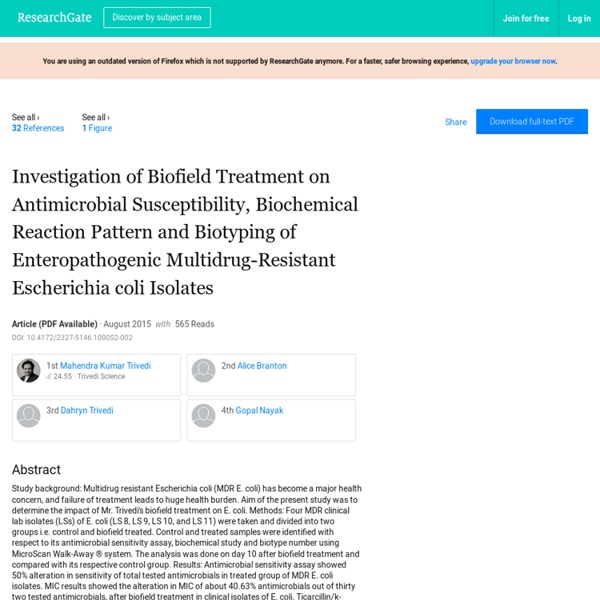Biofield Treatment & Biochemical Characteristics of Yersinia Enterocolitica
Two strains of Yersinia enterocolitica [ATCC –23715] were procured from MicroBioLogics in sealed packs bearing the same ATCC number and stored according to the recommended storage protocols until needed for experiments.
Biotyping of Enteropathogenic MDR Escherichia coli Isolates
Description Study background: Multidrug resistant Escherichia coli (MDR E. coli) has become a major health concern, and failure of treatment leads to huge health burden. Aim of the present study was to determine the impact of Mr.
Research on Escherichia Coli Biochemical Characteristics
Bioeld as an energy medicine has been included in complementary and alternative medicine (CAM) therapies, and very commonly practiced in US by professional healthcare representative [11]. CAM therapies are very helpful to improve the human wellbeing and health without having any side eects.
Yersinia Enterocolitica Biochemical Test/Study – Impact of External Energy
Abstract Background: While spiritual and mental energies are known to man, their impact has never been scientifically measurable in the material world and they remain outside the domain of science. The present experiments on Yersinia enterocolitica [ATCC –23715], report the effects of such energy transmitted through a person, Mahendra Trivedi, which has produced an impact measurable in scientifically rigorous manner. Methods: Yersinia enterocolitica strains in revived and lyophilized state were subjected to spiritual energy transmitted through thought intervention and/or physical touch of Mahendra Trivedito the sealed tubes containing strain and were analyzed within 10 days after incubation.
Experimental results of Escherichia Coli Antibiotic Sensitivity Assay
Study background: Multidrug resistant Escherichia coli (MDR E. coli) has become a major health concern, and failure of treatment leads to huge health burden. Aim of the present study was to determine the impact of Mr. Trivedi’s biofield treatment on E. coli. Methods: Four MDR clinical lab isolates (LSs) of E. coli (LS 8, LS 9, LS 10, and LS 11) were taken and divided into two groups i.e. control and biofield treated.
Human Energy Impact on Thermal Properties of DHBP
Citation: Trivedi MK, Tallapragada RM, Branton A, Trivedi D, Nayak G, et al. (2015) Physical, Thermal and Spectral Properties of Bioeld Energy Treated 2,4-Dihydroxybenzophenone. Clin Pharmacol Biopharm 4: 145. doi:10.4172/2167-065X.1000145 Page 8 of 8 Volume 4 • Issue 4 • 1000145
A research on Mahendra Trivedi’s Unique Energy
Vikram V Dabhade et al chemical processes (Amarchand et al 2000), and electro deposition (Suryanara yana 1995), etc.
Thermal Properties of DHBP after the Human Energy Treatment
Description Study background: 2,4-Dihydroxybenzophenone (DHBP) is an organic compound used for the synthesis of pharmaceutical agents. The objective of this study was to investigate the influence of biofield energy treatment on the physical, thermal and spectral properties of DHBP. The study was performed in two groups (control and treated). The control group remained as untreated, and the treated group received Mr.
TGA Analysis of Biofield Treated 2,4-Dihydroxybenzophenone
Study background: 2,4-Dihydroxybenzophenone (DHBP) is an organic compound used for the synthesis of pharmaceutical agents. The objective of this study was to investigate the influence of biofield energy treatment on the physical, thermal and spectral properties of DHBP. The study was performed in two groups (control and treated).
Soybean Production – Influence of Mahendra Trivedi’s Human Energy
Soybean production in Iowa USA is among the most productive for raínfed regions in the world. Despite generally having excellent soils, growing season temperatures and rainfall, soybean yields are decreased by weed interference and inadequate available soil water at key stages of crop development. A field study was conducted at two locations in lowa in 2012 to determine if seed-applied fungicide or biofield treatments influenced weed community, soil volumetric water concentration and soybean yield and quality.
Menthol TGA Analysis - Evaluation of Energy Medicine
Description Thymol and menthol are naturally occurring plant derived compounds, which have excellent pharmaceutical and antimicrobial applications. The aim of this work was to evaluate the impact of biofield energy on physical and structural characteristics of thymol and menthol.
Impact of Biofield on Thermal Stability of Thymol
0WordPress0CiteULike0 New Thymol and menthol are naturally occurring plant derived compounds, which have excellent pharmaceutical and antimicrobial applications. The aim of this work was to evaluate the impact of biofield energy on physical and structural characteristics of thymol and menthol. The control and biofield treated compounds (thymol and menthol) were characterized by X-ray diffraction (XRD), Differential Scanning Calorimetry (DSC), Thermogravimetric analysis (TGA), and Fourier Transform Infrared Spectroscopy (FT-IR). XRD study revealed increase in intensity of the XRD peaks of treated thymol, which was correlated to high crystallinity of the treated sample. The treated thymol showed significant increase in crystallite size by 50.01% as compared to control.
Mahendra Trivedi’s Energy to Increase the Growth and Yield of Lettuce & Tomato
Aust. J. Basic & Appl. Sci., 6(10): 100-105, 2012



